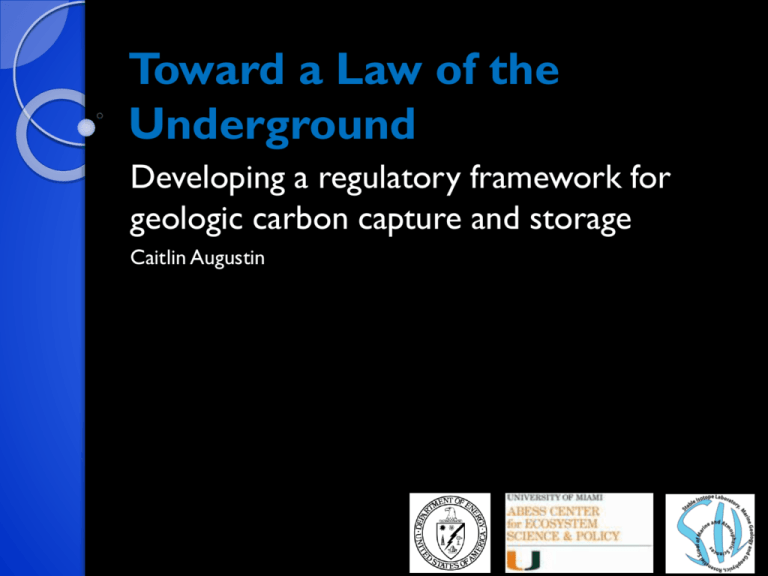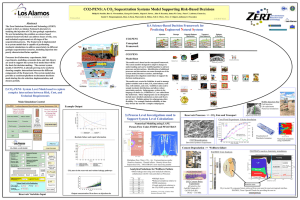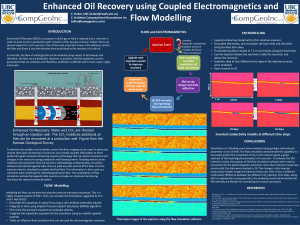Toward a Law of the Underground
advertisement

Toward a Law of the Underground Developing a regulatory framework for geologic carbon capture and storage Caitlin Augustin MVA Project DOE Award # FE0001580 GPS ◦ Measure surface deformation with high temporal resolution InSAR ◦ Measure surface deformation with high spatial resolution Seismology ◦ Measure Vp/Vs at selected test site and locate microearthquakes as indicators of fluid migration Geochemistry ◦ Measure key geochemical parameters at test site TECHNOLOGY BACKGROUND Definition The capture of carbon dioxide from a large point source and subsurface storage in such a manner that it never reaches the atmosphere Storage Sites Zone Type Average Depth of injection (meters) Count of active zones Count of potential zones Oil reservoir (EOR) 1454 1751 1,000+ Depleted Oil/Gas reservoir 1840 942 1,000+ 1500-3000 33 unknown 1800-2300 274 355 planned sites, count unknown Unmineable coal seams Saline water (brine reservoirs) 2. 1. Oil and Gas Journal Enhanced Recovery Survey (2010) Current State of issues concerning Underground Natural Gas Storage (2004) 3. Big Sky CO2 Project 4. CCS @ MIT (2012) Depth measure: US Energy Information Administration Process Adoption Short to mid-term emissions reduction technology It is estimated that geologic carbon capture and storage (CCS) could be used to achieve between 15% and 55% of the carbon emission reductions necessary to avoid dangerous levels of climate change. (IPCC, IEA, IRGC) DISSERTATION PROJECT Problem Statement Fundamentally there is not a clear accounting of what happens to injected carbon dioxide, and there is no clear set of legal guidelines covering CCS Implementation of large-scale, transboundary CCS projects are largely unaddressed. Likely first order scenarios that need to be considered are 1. 2. 1. 2. 3. When CO2 injection is contained within one state, but there is the potential for CO2 migration towards or subsurface pressure changes in a neighboring state Situations where the storage reservoir spans one or more political boundaries There exists an inadequate and incomplete probabilistic risk assessment framework for evaluating potential leaks and health impacts Objectives 1. 2. 3. 4. 5. Understand subsurface reactions in storage reservoirs at the field-scale Develop a probabilistic risk assessment for future geologic sequestration scenarios Expose the inadequacies of existing legal frameworks governing CCS Analyze transboundary security issues stemming directly from CCS Propose a framework for a Law of the Underground Expected Contributions 1. 2. 3. 4. First geochemical models of Teapot Dome, Wyoming First Bayesian risk analysis of CCS First Bayesian risk analysis of natural CO2 leaks First comprehensive Law of the Underground Related Research Geology Engineering Policy Caraballo AC, Rabindran P, Winning G, et al. (2010) Vinogradov (2011) Bradsher, K and Barboza, D. (2011) Bertinelli, L., Camacho, C. and Zou, B, (2011) Wilkinson et al (2009) Birkholzer (2010) Hart (2011) Luquot et al (2009) Zerai et al (2006) Chabora and Benson (2009) Nordbotten (2008) White et al (2005) Class, H et al. (2009) Xu et al (2005) Englehardt, J.D. (1995) Hardisty et al (2011) Endres (2010) De Figueiredo et al (2006, ‘07, ‘09) Rubin, E.S., McCoy, S.T., Apt, J. (2005) Rissland, E. L., Ashley, K. D., & Branting, L. K. (2005) Policy Methodology Geology Engineering Predictive Risk Assessment Reactive Transport Modeling Reservoir Characterization Case-based Legal Research A Law of the Underground Differential Games Modeling DISSERTATION DATA SOURCES Theoretical dataset Class, et al 2009 ◦ “A Benchmark study on problems related to CO2 storage in geologic formations Parameters ◦ ◦ ◦ ◦ ◦ model domains model input parameters, boundary conditions simulation times expected model outputs Class, H ,et al. (2009) “A benchmark study on problems related to CO2 storage in geologic formations.” Computational Geosciences 13.4: 409-434. Case Study dataset DOE Rocky Mountain Oilfield Testing Center ◦ ◦ ◦ ◦ ◦ ◦ Injection schedule Lithology Injectant data GIS maps Well logs Core data (porosity and permeability) ◦ Seismic From DOE dataset Case Study site: Teapot Dome, WY CO2 injection into three unique formations (Tensleep, Shannon, 1st Wall Creek) Situated near major metropolitan area Reservoir borders Native American territorial lands Map of NPR-3 Injection Site Natural CO2 Leaks dataset 290 point dataset compiled dataset from ◦ Googas Database ◦ USGS Volcanics ◦ EPA Data contains ◦ Volume (metric tons) leaked per 24 hours ◦ Type of leak ◦ Human fatalities ◦ Human injuries ◦ Animal fatalities ◦ Latitude/longitude Map of Googas database leak locations Commercial Leaks dataset 18 point dataset compiled from ◦ News sources ◦ Literature review Data contains ◦ Volume (metric tons) leaked per 24 hours ◦ Type of leak ◦ Latitude/longitude ◦ Human fatalities* *not available for all sites Leak at Weyburn, Canada injection site DISSERTATION CHAPTERS Ch 1: Introduction Motivation for the Study ◦ CCS is performed by public and private actors across local, national and international governments ◦ The cross-cutting nature of CCS means law has been created without scientific basis, leading to unrealistic monitoring standards and arbitrary injection frameworks ◦ Law is proposed and interpreted at all levels, from the local to federal to international, leading to overlapping and conflicting regulatory regimes Ch 1: Introduction Description of the Knowledge Gaps ◦ Subsurface interactions: There is a need for a better understanding of long-term storage, migration and leakage processes. ◦ Probabilistic Risk Profiles: To date, there have been no few at quantifying risk on a site by site basis using probabilistic methods, and no attempts at quantifying on a larger scale. Furthermore, no research has been undertaken to do predictive Bayesian modeling on GCCS site information and use these techniques to develop a risk profile for future injection scenarios. ◦ Regulation: Current knowledge about the legal and regulatory requirements for implementing GCCS remains inadequate. There exists no appropriate framework to facilitate the implementation of GCCS and manage the associated long-term liabilities. Clarification is needed regarding potential legal constraints on geological storage (either terrestrial or sub-seabed.) Ch 1I: 3-D Reservoir Characterization—Chapter Overview This chapter will focus on the development field-scale reservoir models of potential injection sites. These models are intended to form the basis of the reactive-transport models of CO2 injection in Ch II Potential fields must be characterized on reservoir architecture and lithology ◦ This characterization can highlight potential injection hazards such as groundwater contamination, pressure build up, and fracture/fault presence. Software ◦ PetraSim ◦ Trinity 5,000 and 10,000 point grids Data ◦ Class, et al ◦ Teapot Dome Petrasim benchmark problem(reservoir is stratified based on lithology) Petrasim problem (reservoir is inverted, stratified based on teperature) Ch 1I: 3-D Reservoir Characterization—Chapter Approach Ch 1I: 3-D Reservoir Characterization— Preliminary Results/Next Steps Tough 2 has no visualizer and is cumbersome to work with ◦ PetraSim is a far easier tool Tough 2 cannot handle oil as a fluid ◦ Use basin modeling techniques from petroleum geology which allow oil to behave as a fluid Trinity software Zetaware Trinity © Basin Model of an unnamed oil field Ch III: 2-D and 3-D Reactive Transport Modeling—Chapter Overview This chapter will present the results of modeling of CO2–brine–mineral reactions in sandstone, carbonate, and mixed mineral assemblage reservoirs The 2-D reactive transport models should demonstrate mineral-trapping and solubilitytrapping of CO2 over specified time scales The 3-D models should show the evolving pressure field over an injection site, the migration of the CO2 plume over time, and the reservoir deformation resulting from injection Software ◦ PetraSim ◦ Geochemist’s Workbench 5,000 and 10,000 point grids 20, 50, 100 year reaction periods Data ◦ Class, et al ◦ Teapot Dome Precipitation of dawsonite e from a sandstone reservoir Precipitation of siderite from a sandstone reservoir Ch III: 2-D and 3-D Reactive Transport Modeling—Chapter Approach Ch III: 2-D and 3-D Reactive Transport Modeling— Preliminary Results and Next Steps We discovered a glitch in GWB models where more carbonates were precipitating than possible Attending a summer 2013 GWB training workshop Reaction path modeling from Zerai, et al (2005) Chapter IV: Predictive Risk Assessment —Chapter Overview With GCCS, it will be impractical and impossible to collect comprehensive empirical data regarding geologic reservoir leaks. For these reasons, together with the expense of field data collection, there is a need for a statistical technique integrating limited data collection with stochastic modeling. Predictive Bayesian modeling techniques have been developed and demonstrated for exploiting limited information for decision support in many other situation, this chapter will adapt and apply them to CCS. Chapter IV: Predictive Risk Modeling—Chapter Approach Develop a probabilistic risk profile using a compound Poisson model ◦ Incident frequency modeled using the predictive Bayesian form of the Poisson distribution ◦ Incident size modeled using the predictive Bayesian form of the truncated Pareto I distribution Run a 1,000,000 point Monte Carlo simulation with 100,000 sampled for replacement 1000 100 10 1 0 0.1 0 log (probability density) 10 1000 100000 10000000 0.01 0.001 0.0001 0.00001 0.000001 0.0000001 1E-08 1E-09 1E-10 log (incident sizes) Empirical PDF for natural leaks historic data Chapter IV: Predictive Risk Modeling—Preliminary Results ◦ (Robers , 2011) “more likely to be struck by lightening than die from CCS leak” 1000 10000 100000 0.0001 0.00001 0.000001 0.0000001 1E-08 log (n*z total incident size) metric tons Resulting compound distribution over a 20 year planning period This first application of Bayesian methods to the carbon capture and storage problem corroborates recent research results from other schools 100 0.001 0.7000 0.6000 0.5000 0.4000 0.3000 0.2000 0.1000 0.0000 0 20000 40000 60000 80000 total leakage volume 100000 Resulting probability distribution over a 20 year planning period ◦ results of this simulation show that the probability of large volume leakage is so small that the risk would actually be classified as “low” 0.01 log (probibility density) In risk analysis, the formula “Risk = Probability × Consequence” is applied as a way to categorize high, medium, and low risk scenarios probability Chapter IV: Predictive Risk Modeling—Next Steps Build model based on known commercial leak data Compare commercial leak profile and natural leak profile Chapter V: Legal analysis—Chapter Overview Intergovernmental agencies have focused on regulating isolated components of CCS rather than the process as a whole. CCS does not fall easily within the regulation of international legislation, as existing laws were designed prior to this technology being developed. Very few countries have developed the necessary frameworks for sequestration regulations and in many cases haven’t even determined which regulatory authorities have jurisdiction. Intergovernmental laws, national laws from the 50+ countries adopting GCCS, and regional laws from major adopters (such as the United States) will be analyzed. Chapter V: Legal analysis—Chapter Approach “case-based” approach ◦ Simply put, the present problem of interpretation must be solved based on the solutions to similar past problems. ◦ In particular, one tries to resolve interpretation problems by considering past applications of the rules and terms in question: by examining precedent cases, comparing and contrasting these with the instant case, and arguing why a previous interpretation can (or cannot) be applied to the new case., Chapter V: Legal analysis— Preliminary Results and Next Steps Categorized all property law regimes in relation to subsurface ownership Identified all laws governing (or potentially governing) carbon dioxide Identified international laws governing (or potentially governing) CCS Chapter VI: Transboundary Security Situations—Chapter Overview Chapter VI: Transboundary Security Situations—Chapter Approach ◦ ◦ ◦ ◦ ◦ ◦ Game theory will be applied to a transboundary injection model with two actors Countries commit to an emissions reduction target Emissions potential stays constant Cost of reduction of one emissions unit Penalty cost of not reducing one emissions unit Noncooperative model Individual economic success optimized Cooperative model Joint economic success optimized Based on Olli Tahvonen (1994) “Carbon dioxide abatement as a differential game” Chapter VII: Law of the Underground Subsurface ownership Treatment of carbon dioxide Liability regimes Disaster mitigation Timeline Percentage completed/ topic Bayesian Models: natural leaks Bayesian Models: commercial leaks Legal Analysis 3-D Reservoir Characterization (Trinity) 3-D Reservoir Characterization (PetraSim) 2-D Reactive Transport Modeling 3-D Flow Modeling Differential Games Modeling Policy Recommendations 10% 20% 30% Problem designed and model built 40% 50% 60% Data collected 70% 80% 90% Analysis run and refined 100% Writing chapter Spring 2013 Spring 2013 Spring 2013 Summer 2013 Fall 2013 Fall 2013 Spring 2014 Summer 2014 Fall 2014






